SAN DIEGO – The Society for Cardiovascular Angiography and Interventions (SCAI) has released new guidelines to address the selection of specific categories of devices when endovascular therapy (EVT) is indicated. The purpose of this document, which is the first of its kind, is to provide a review of comparative effectiveness data, including safety and efficacy of femoral-popliteal (FP) devices, and to provide clinicians with guidance and recommendations for device selection when these devices are intended as the definitive or adjunctive therapy. The document is available in early-view online in SCAI's official journal, Catheterization and Cardiovascular Interventions.
There is widespread uncertainty about device selection for EVT due to clinicians having many options and opinions with limited data to distinguish between them. The SCAI writing group reviewed and considered data on safety, efficacy, and cost-effectiveness when making device-specific recommendations. Data sources included randomized clinical trials, meta-analyses, nonrandomized trials, observational studies, case series and registry data.
"SCAI has a long history of prioritizing quality initiatives in the field of endovascular therapy for peripheral artery disease. Device choices for endovascular therapy, particularly in the femoral-popliteal interventions, remain challenging due to a wide spectrum of available device options and a paucity of comparative effectiveness data," said Dmitriy Feldman, MD, FSCAI, chair of the writing group. "Current guidelines do not address the selection of specific devices when endovascular therapy is indicated. This is the first SCAI-led device-focused consensus guidelines document, which provides a focused review of comparative effectiveness and safety data for femoral-popliteal devices," Dr. Feldman continued.
The document, which makes recommendations for both definitive and adjunctive therapy scenarios, identified several areas for future research, including trials on value and cost-effectiveness of devices in specific clinical circumstances and lesion subsets. In addition, the guidelines recommend that future studies adopt the Peripheral Academic Research Consortium (PARC) definitions for clinically meaningful outcomes and endpoints. The recommendations in this consensus guidelines document are a first step to provide clinicians with relevant anatomical scenarios to guide device selection based on strength and quality of evidence for comparative effectiveness, durability, and expert opinion.
###
About SCAI
The Society for Cardiovascular Angiography and Interventions is a 4,200-member professional organization representing invasive and interventional cardiologists in approximately 75 countries. SCAI's mission is to promote excellence in invasive/interventional cardiovascular medicine through physician and allied health professional education and representation, and advancement of quality standards to enhance patient care. For more information about SCAI, visit http://www.SCAI.org. Follow @SCAI on Twitter for the latest heart health news.
Media Contact
Kim Brown
[email protected]
202-498-2601
http://www.scai.org





